What Are the Three Sections of the Ap Art Design Portfolio
In 2019, Higher Board revamped the construction and assessment of the Avant-garde Placement Fine art and Design Portfolios (previously known as AP Studio Art). This threw many teachers for a loop. Afterwards spending years perfecting pacing schedules and lesson plans, teachers weren't exactly sure where to start. Whether y'all are new to AP or a veteran teacher, understanding the portfolio can be a bit confusing.
Allow's suspension down what this portfolio is all nearly and so we can prepare students for submission.
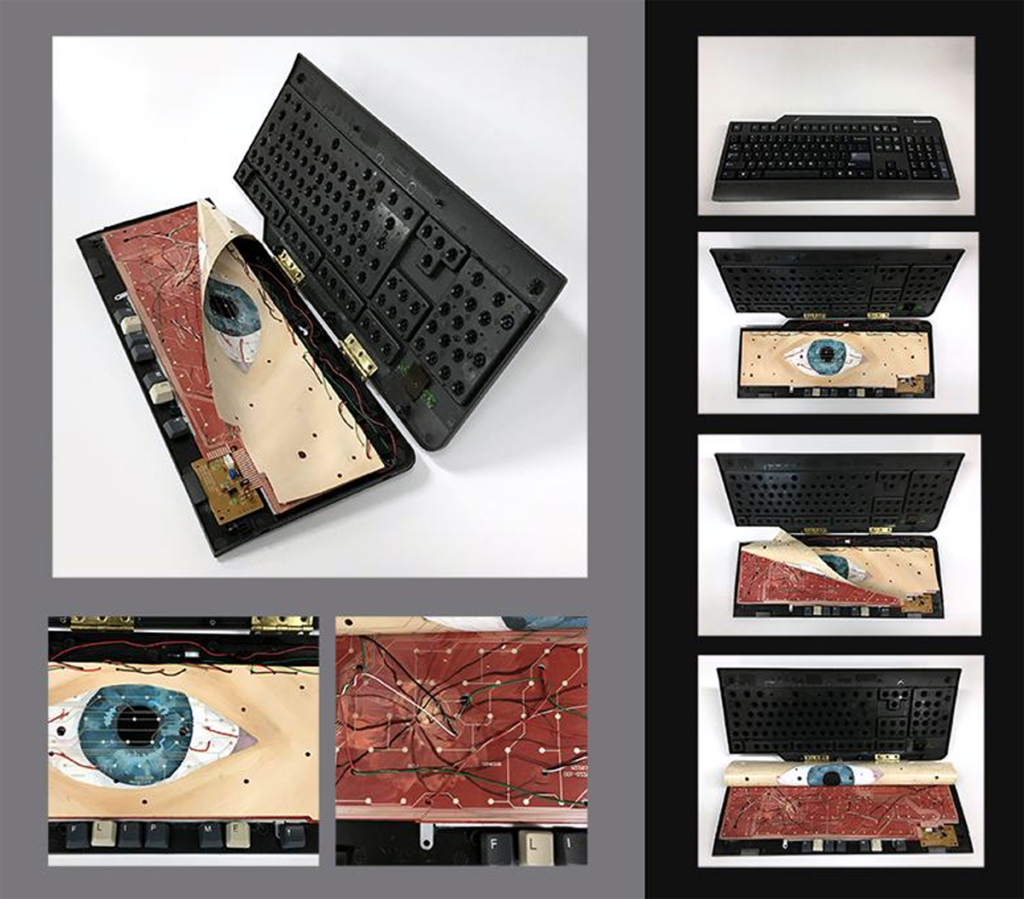
The AP portfolio is a collection of process images, finished artworks, and writing that emphasizes disquisitional thinking and intentional decision-making. Artworks must testify an understanding of pattern and art concepts. They must also show a synthesis of materials and ideas through exercise, experimentation, and revision. In the ii portions of the exam, students volition create anywhere from six to twenty developed artworks.
Students can develop artwork for either 2D Design, 3D Blueprint, or the 2D Drawing portfolio. They can submit to more than ane portfolio in a given year (or over 2 years), but there must be completely carve up and unique artworks per portfolio. While all three portfolios are structured the same, each is assessed based on different visual concerns. Therefore, each portfolio has a specific rubric with different criteria.
Portfolios are submitted both digitally and physically (see below) for scoring. The deadline for submission is typically inside the first two weeks of May.
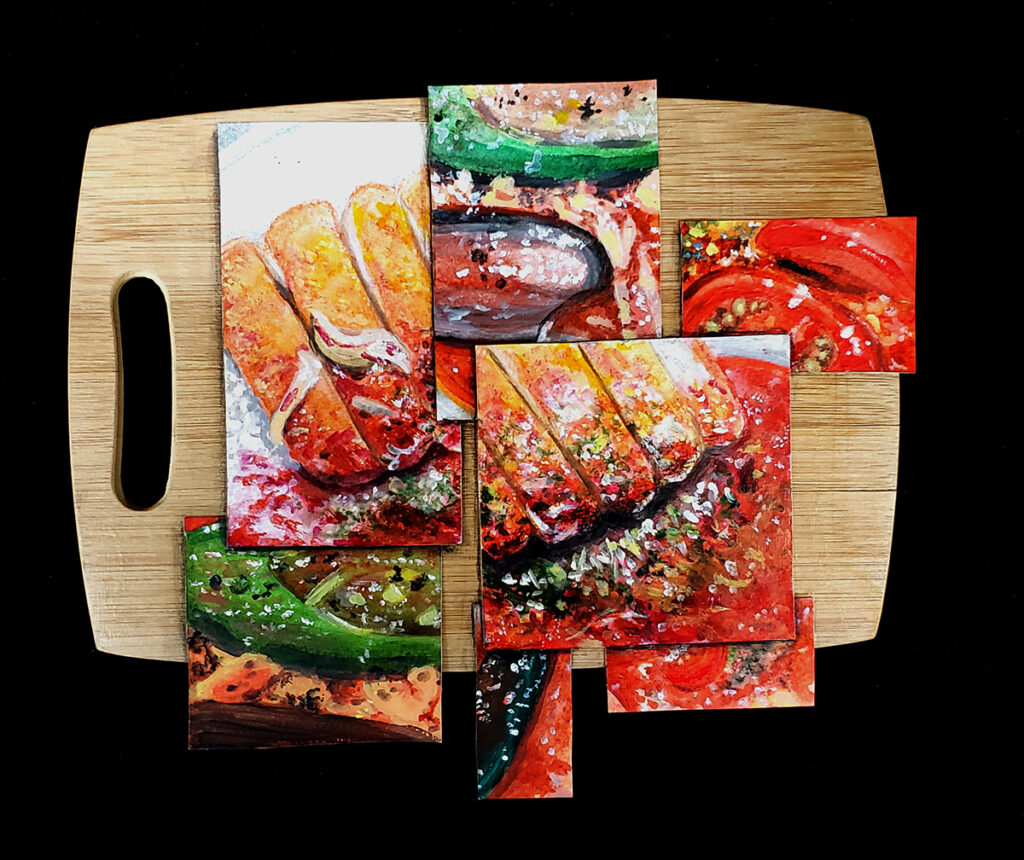
To assist brand the requirements easier to understand, nosotros created an at-a-glance guide just for you! This volition exist a handy download to keep bookmarked on your computer or posted on your bulletin board.
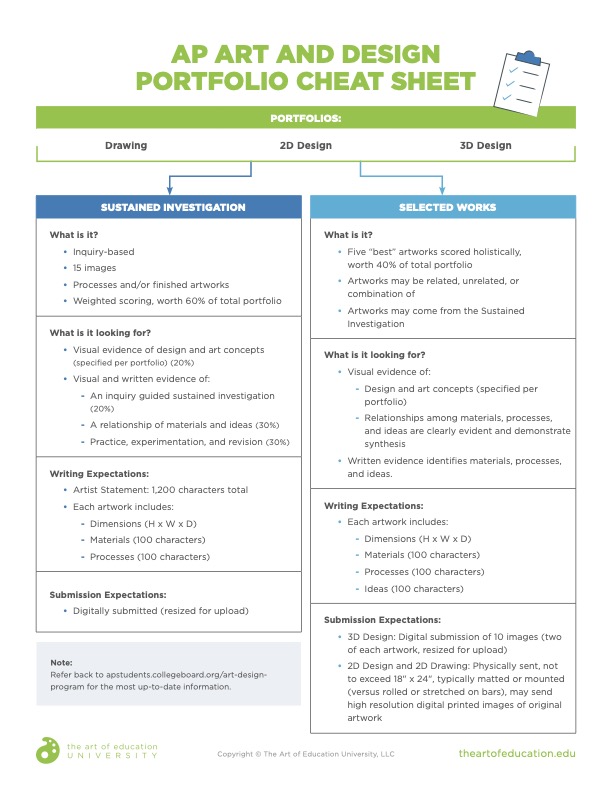
Download Now!
The Breakdown
In order to make the shift into the portfolio requirements, there are a few big changes from the previous portfolio to go on in mind.
Structure: The portfolio is divided into ii sections instead of three.
Previously, the AP portfolio consisted of three sections:
- Latitude: 12 artworks that demonstrate a range of methods and approaches.
- Concentration: 12 artworks that respond to a chosen theme or topic.
- Quality: five artworks that show the best quality, pulled from the Latitude or Concentration sections or completely separate artwork.
The new portfolio consists of the following ii sections:
- Sustained Investigation: xv images relating to a student-developed enquiry question.
- Selected Works: 5 high-quality artworks.
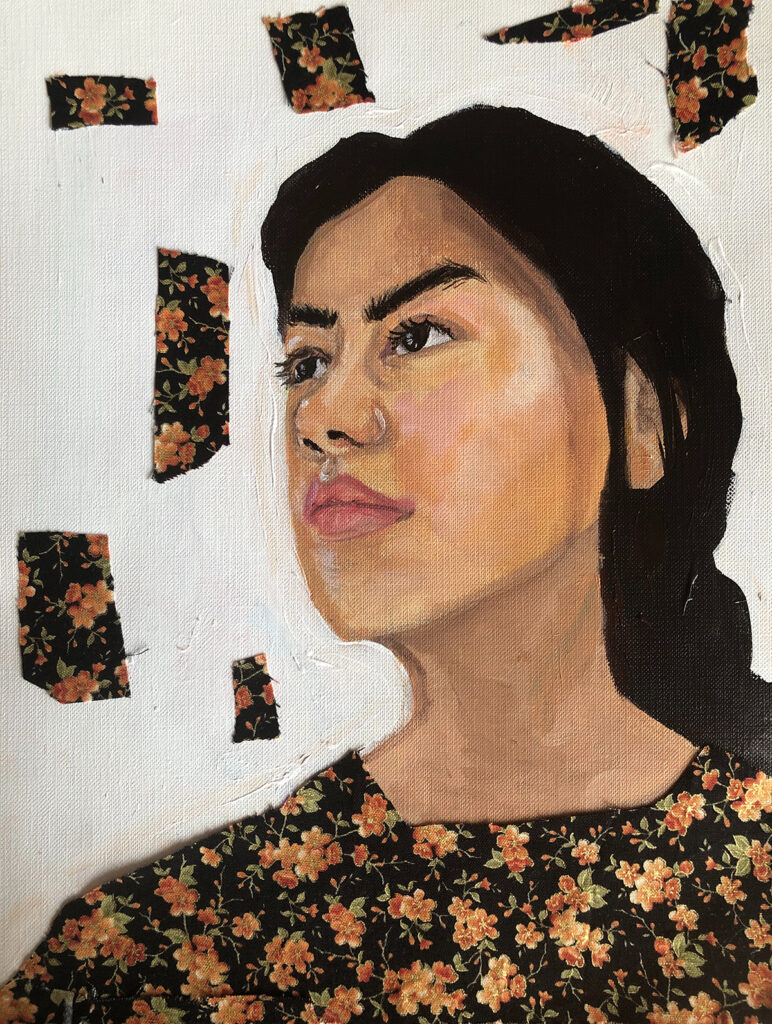
Artwork Requirements: There are fewer artworks required and the expectations take changed.
In the previous portfolio, students created around 24 resolved artworks. Now, AP asks students to submit fifteen images for the Sustained Investigation and five artworks for the Selected Works portion.
Students practise not have to submit 15 finished artworks for the new Sustained Investigation but rather 15 "images." This is a scrap challenging to wrap your caput effectually. With this new Sustained Investigation, the emphasis is on demonstrating practice, experimentation, and revision through a variety of images. Of course, students can submit 15 finished artworks in which those processes are visually evident. Students could likewise, for case, submit 8-10 finished artworks along with some revision and process images. Or a educatee could fifty-fifty submit i complex artwork, such as a mural, with xiv process and revision images.
The Selected Works can come from the Sustained Investigation but they don't have to. Therefore, students do non demand to develop more than than 15 artworks. This feels more manageable than the previous requirements, especially with express class time.
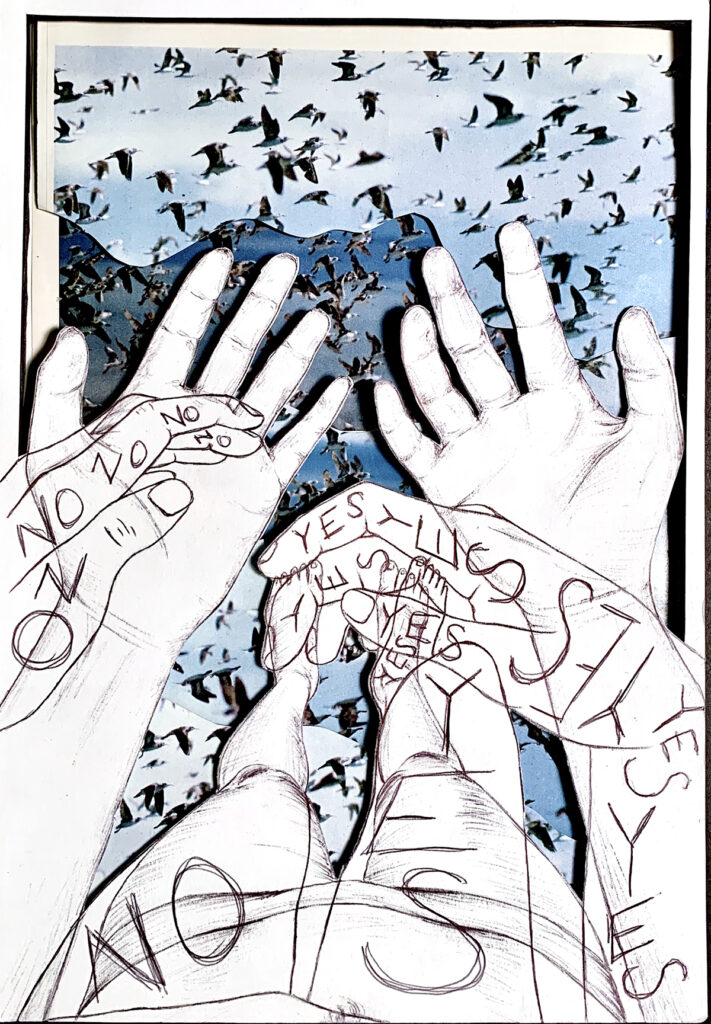
Cess: The portfolio focuses on the development of ideas, processes, and synthesis of media over fourth dimension.
Both Sustained Investigation and Selected Works are steeped in connecting visual creative decisions evident in the artwork with disquisitional thinking and intentional decision making.
The Sustained Investigation is inquiry-based. Starting with an inquiry question, students and so develop artworks that answer the inquiry. This oft results in the creation of a new prepare of questions that leads students down a rabbit hole of conceptual thinking. According to AP, the artworks must "demonstrate your inquiry-based sustained investigation of materials, processes, and ideas done over time through practice, experimentation, and revision."
Like to the previous portfolio, the Selected Works includes the students' best works. However, these works also should "demonstrate good synthesis of materials, processes, and ideas."
For example, a student may create a self-portrait painted with acrylic paint. In this portfolio, the pupil would need to explain the why, the how, and the connectedness between decisions made and the completed artwork.
When information technology comes to cess, AP provides a rubric with established criteria for each section. Make sure to reference these rubrics as y'all assess student work. While all three portfolios address the same overarching concepts of the Sustained Investigation and the Selected Works, each portfolio (second Blueprint, 2D Cartoon, or 3D Design) has different criteria for their visual concerns and artistic methods.
The Sustained Investigation has weighted categories within the rubric and is scored on a 3 point calibration. It is weighted heavily at 60% of the total portfolio score. The Selected Works portion is scored holistically on a v indicate scale and is worth 40% of the overall score.

Writing: The portfolio includes writing which is weighted more heavily than in the past.
Similar to the previous portfolio, students nevertheless write an artist argument that is 1200 characters, split into two sections that are 600 characters each. This statement examines their Sustained Investigation from inquiry question to supporting evidence. Students apply this infinite to communicate ideas. The offset section identifies the inquiry question. The second section describes how processes and ideas used in their artworks chronicle to their enquiry. Both sections are assessed using unlike parts of the Sustained Investigation rubric.
In addition, each image has space to include a short amount of text. For each epitome, students have 100 characters to explicate processes explored and 100 characters for materials used. This is the instance for both the Sustained Investigation and Selected Works. According to the rubric, much greater consideration is given to student writing than in the previous portfolio.
Submission and Scoring: The portfolio submission process is similar to previous years.
The Sustained Investigation is a digital submission procedure for all iii portfolios through the AP College Board site. The Selected Works are a digital submission for the 3D Design portfolio while the 2d Blueprint and 2nd Drawing portfolios are physically packed up and sent to AP. Your school'due south AP coordinator receives portfolios and labels for students to pack their works, as well as large boxes to ship the work to AP. Artworks must be flat (no stretcher bars), no larger than xviii×24" (though loftier-quality printed reproductions are acceptable), and can exist matted and/or mounted for rigid support. Artwork is returned dorsum to students' homes after scoring, former in late summer.
Both digital and physical works will be scored past teams of art educators who apply for the opportunity to be an AP Reader. These readers nourish training with exercise portfolios. Artwork and computers line tables in a large hanger. Because of the large amount of work to score, readers spend mere minutes of time reviewing each portfolio. Therefore, their scoring practices must be well-aligned with the rubrics. Portfolios are scored by more than ane reader to check for reliability and each department is scored past a different grouping of readers.
The portfolios are then scored out of a total of 6. You volition notice, however, that the final score is out of a possible 5 points. When scoring out of six possible points, a bell bend is created to develop a mean, and scores are aligned to a 5-point scale.
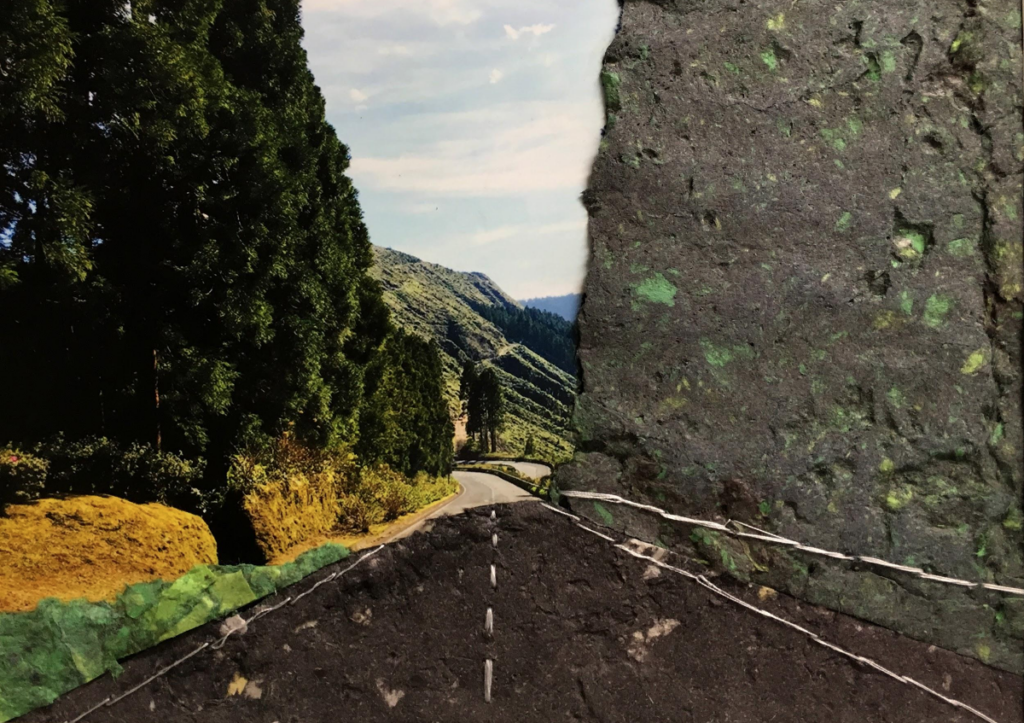
Navigating the Portfolio
To larn more than about this process and nearly the AP exam, you tin attend a workshop offered by College Board. The in-person, week-long sessions are ofttimes hosted past local universities effectually the US. I recommend attending a session to further sympathize the portfolio and scoring processes. AP Classroom is another dandy resource for you and your students. Teachers tin register for AP Webinars and subscribe to the AP YouTube Channel for videos that explain these concepts further. You can even take a look at previous sample portfolios and scoring rationale (this one is for 2d Blueprint) through the College Board site.
As y'all learn to navigate the ins and outs of the Advanced Placement Fine art and Pattern portfolios, you will find yourself pushing students' thinking. While the new portfolio is challenging, it's heady to watch students brand deeper connections with their artmaking practices. Completing a portfolio and submitting information technology to AP is a huge achievement. Regardless of the score, gloat your students (and yourself!) for this tremendous feat.
For more conversations around AP Art and Design, cheque out these two podcast episodes:
- Breaking Down AP Portfolios, Role 1 (Ep. 289)
- Breaking Downwardly AP Portfolios, Part 2 (Ep. 290)
What is yet puzzling to you about the updated AP requirements?
What other AP resources have been helpful to you?
Magazine manufactures and podcasts are opinions of professional education contributors and practice not necessarily represent the position of the Art of Education University (AOEU) or its academic offerings. Contributors utilize terms in the mode they are nearly oftentimes talked almost in the telescopic of their educational experiences.
Source: https://theartofeducation.edu/2022/02/11/feb-how-to-easily-break-down-ap-art-and-design-portfolios/